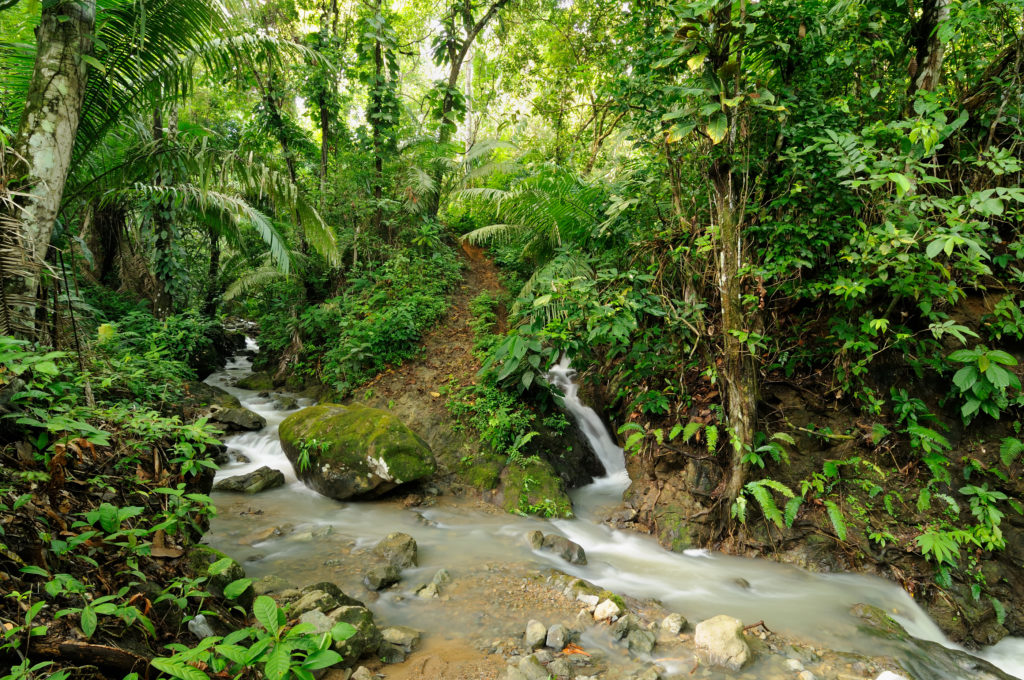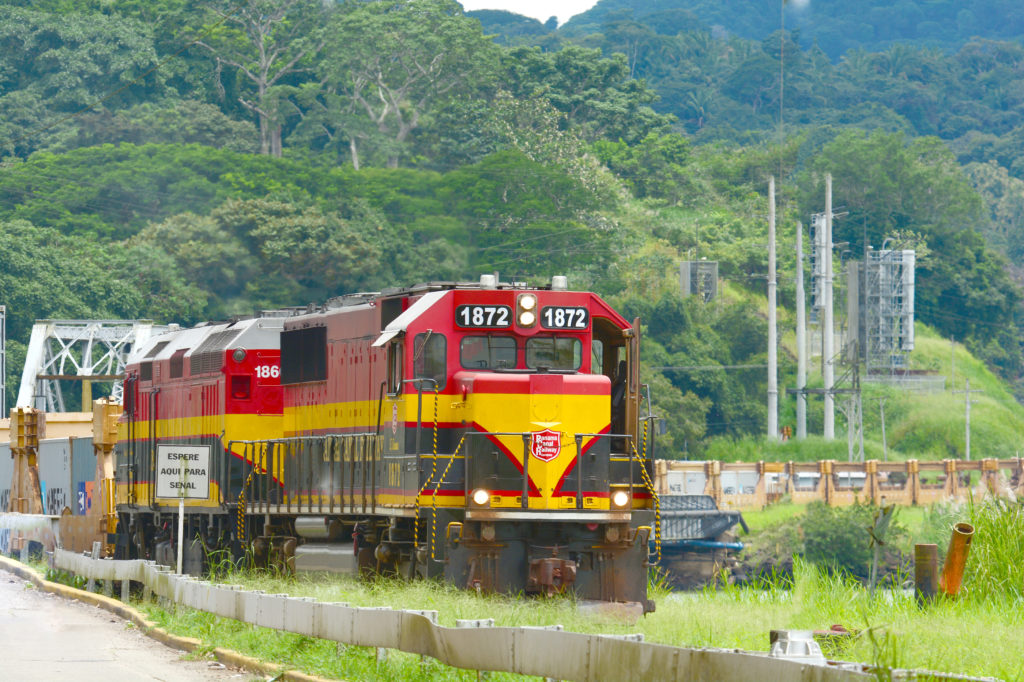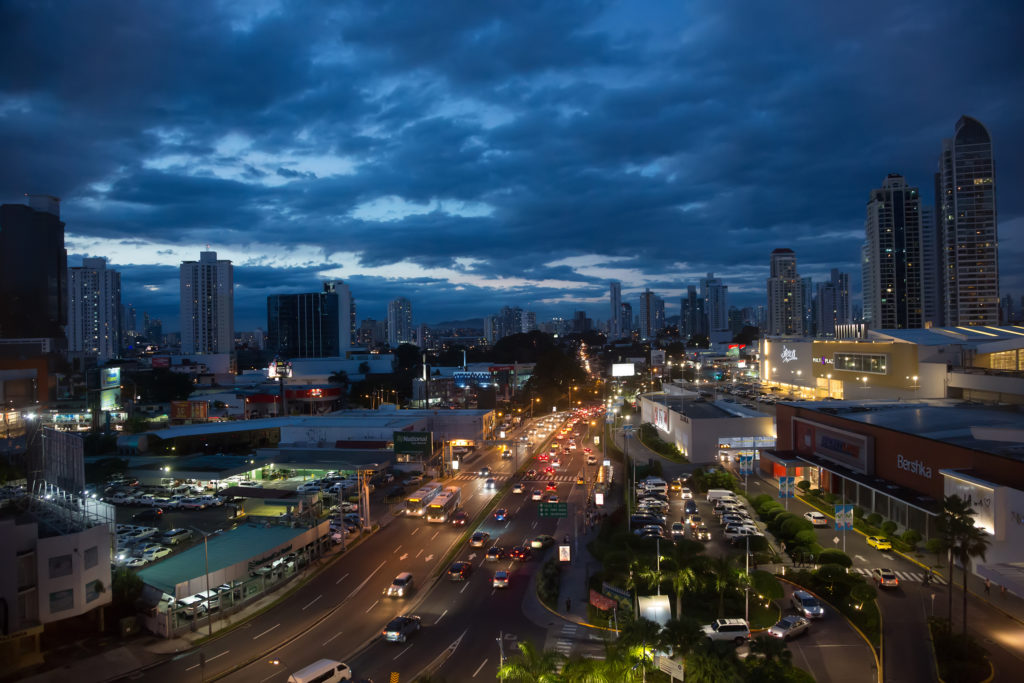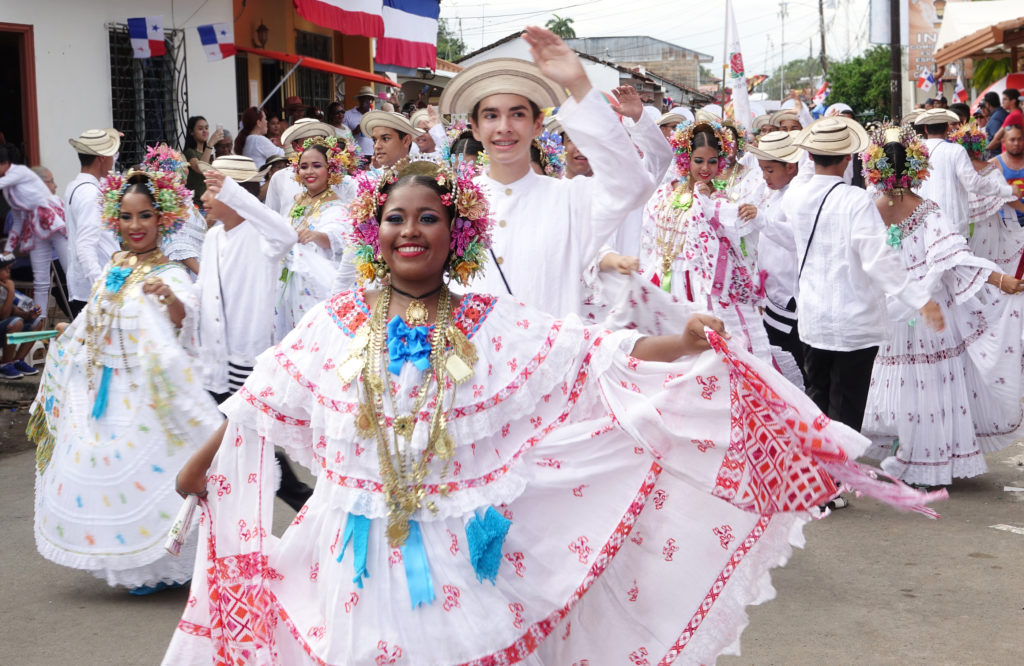
Darien Jungle 
Panama Canal Railway Company 
Panama City, Panama 
Traditional dress, the pollera, at a procession in Los Santos.
Quick: what comes to mind when you think of Panama? Shipping? International finance? The Canal? To be sure, Panama is all that, but it’s so much more.
This country is pretty amazing and the fact that it’s fairly off radar compared to other vacation destinations is very much in its favor: forts are open for exploration sans tickets and lines, beaches are unspoiled, and the museums have little to no waiting lines.
Panama is divided into 10 provinces plus the Panama Canal Zone, each with its own charm. Let’s take a look at each one—really only a glimpse of the many incredible attractions this country holds—and hopefully we can set you up with a SkyMed Personal Travel Advisor to create your own Panama voyage!
Province of Panama
This is home to Panama City, the famous Panama Canal, the ruins of Panama
The busy Old Town, built on the ruins of earthquakes, fires, and pirate invasions is today home to the best restaurants and nightlife. Standouts include the Vaults (Las Bóvedas), old churches, the Panama Canal Museum (Museo del Canal Interoceánico de Panamá)—devoted to the history of the construction of the Panama Canal in its various stages—, and beautiful colonial buildings.
This tropical country is very culturally diverse, welcoming its visitors not only with modern skyscrapers and shopping centers, but also with extraordinary natural beauty, a brilliant array of ethnicities, and the gastronomy to go along with it. And, it’s easily accessible via non-stop flights from several gateways in the United States via major carriers.
The Panama Canal
This marvel of modern engineering deserves its very own segment. The canal is an inter-oceanic navigation path that crosses the Isthmus of Panama from the Caribbean Sea to the Pacific Ocean. Each year some 14,000 ships make the crossing bearing 300 million tons of goods—a whipping 5% of world trade. Daily the Canal sees anywhere between 35 and 40 ships a day.
The best way to see the canal is from the Miraflores Visitor Center on the east side of the Miraflores Locks. This will allow you to watch the big ships travel the last section of the canal and its locks, which fill with water to lift and lower these huge vessels until they reach the Pacific. The Center houses a theater, three observation terraces, a restaurant with views of the canal, a gift shop, four exhibition halls, and snack bars.
However, the absolute best way to see the canal is… on a cruise! The Canal is 48 miles long and is navigated by over 20 of the world’s top cruise lines including Disney, Celebrity, Royal Caribbean, and Holland America, among others. Contact your SkyMed Personal Travel Advisor to set up this unforgettable journey!
Province of West Panama
This part of the country is home to the Pacific Mountains that stretch from Penonomé to La Chorrera. The Valley is a crater of a volcano, ringed with beautiful summits with amazing views of the valley and the Pacific Ocean.
The Altos de la Campana National Park was the first national park created in the Republic of Panama: 4,952 hectares of protected area bordering the coast of Chame and its floodplains. The park rises 400 meters about sea level at its lowest point up to 1,030 meters at the Pico Campana. At the summit there’s a cross, and there are several hiking trails (including the Sendero de la Cruz, the Path of the Cross), where you can enjoy a spectacular view of the Pacific Coast.
Province of Coclé
The northwest of Coclé is home to the protected Parque Nacional Omar Torrijos. The Pacific Coast beaches are to the south, with the Valle de Antón to the west. One of the most famous peaks in the Province of Coclé is La India Dormida, the Sleeping Indian. There’s a trail that starts at La Piedra Pintada and leads to the top of the hill: the views of the Valle de Anton are breathtaking. The El Níspero Zoo is in that valley, a showcase of the fantastic array of plants and animals from the area.
The valley is a top spot for eco-activities including hiking, biking, bird-watching, and zip-lining. After a long day of fun, head to the Pozos Termales hot springs for to loosen up the muscles or the white-sand beaches of Santa Clara or Farallón.
Province of Veraguas
The Province of Veraguas in central Panama is the only province in the country with coasts on the Atlantic and the Pacific, not to mention having the greatest number of natural parks in the country. One of these, the Parque Nacional Santa Fé, known for its incredible diversity of bird species including the spectacular harpy eagle, not to mention monkeys and all kinds of amphibians. It’s also a habitat for a few jaguars, though they’re rarely seen. Another stellar protected area, the Parque Nacional Coiba, is just off the southern coast and welcomes visitors with dozens of islands.
Province of Herrera
This province is mostly in the interior of the country, though it does have a little Pacific coastal area in Boca de Parita. This is the smallest province in Panama, but it doesn’t lack for tourist attractions, from the colonial town of Paritas with its Religious Art Museum (a national monument), the historic town of Chitre, and the 8,000-hectare Parque Nacional Sarigua with its amazing amphibians and incredible landscapes, to the traditional festivities: Corpus Christi in Parita and the carnivals.
Province of Los Santos
Located on the Azuero Peninsula, Los Santos is home to the lovely colonial city of Villa de
The beach at Tonosí is an important natural reserve where sea turtles nest. Thirty minutes offshore, Isla Iguana is a protected area home to about 5,000 frigate birds. The capital of the province, Las Tablas, is known in Panama as the epicenter of the country’s most spectacular and flashy celebration of Carnival every February.
Province of Chiriquí
This western province is a fertile area produces the best coffee in the world: Geisha from the Esmeralda farm. It’s also adventure central: hiking, rafting, and rappelling in Boquete; climbing the Barú Volcano and exploring the town of Volcán; swimming in the spring waters of Los Cangilones de Gualaca; or sport fishing around the remote Isla Parida.
Province of Bocas del Toro
Nature continues to be front and center in this Panamanian province: the gorgeous deserted keys of Zapatilla in the Bastimentos Island National Marine Park, a wonderland of filled with wildlife (sloths, tropical birds, howler monkeys, tropical birds, and more); the Porras Lagoon, also known as Dolphin Bay for its resident pod of bottle-nose dolphins; Playa las Estrellas, named for the hundreds of starfish that dot the sands of this calm beach; and Boca del Drago, a natural habitat for armadillos, sloths, monkeys, alligators, a cave that’s home to three different species of bats; and much more.
Province of Colón
Among Colón’s many tourist attractions are the Casco Antiguo Colón (Colón Old Quarter) and the Colón Free Zone, one of the main import/export centers of the region and the largest free trade zone in the continent. The Old Quarter is an architectural marvel, with standout buildings including the Railroad Company building, the Panama Railway Station, and the Governor’s office, among others.
Cruise goers will enjoy the Home Port in the city of Colón, a tourist development complex with a cruise port, information center, shops, an aquarium, restaurant, and more. This is also the home of the revitalized Panama Canal Railway Company, a luxurious passenger service that takes travelers on a Two-Ocean Journey through the lush forests that border the Panama Canal—a favorite of cruise ship passengers.
Province of Darién
Located in the east part of the country, Darién is the least populated province as well as the most inaccessible from Panama City. This enormous stretch of jungle encompasses the Darién Gap, the natural barrier of forest that separates Panama from Colombia. Darién is home to the indigenous community of La Chunga, where its people still live according to their ancient traditions.
This is part of the Emberá-Wounaan district, one of three main indigenous districts in Panama. The area also contains the Bagre Bio-Corridor, which joins the Darién National Park and Punta Patiño Nature Reserve.
The mountain range incorporates over 30,000 hectares of land, allowing thousands of species to flow between these two zones. This is the habitat of the giant harpy eagle, the largest raptor in the Americas.
The Guna Yala Region
This region is inhabited by the ethnic Guna, the first inhabitants of Panama and creators of the famous mola textile designs. The region borders the Caribbean Sea to the north, which is dotted with an archipelago of 365 islands around the coast, 50 of which are inhabited.
Isla Perro, or Achudub in Guna, is one of the most visited islands thanks to its beautiful beach and the sunken ship offshore, great for snorkeling. Visitors are welcome to stay in cabins or amp there for the night. Isla Iguana, or Aridub, and the islands of Chichime and Aguja—all white-sand beauties—are among the few other islands that offer accommodations.
This is but a postcard of all that Panama offers. To see more about this fascinating country, go to https://visitpanama.com/







